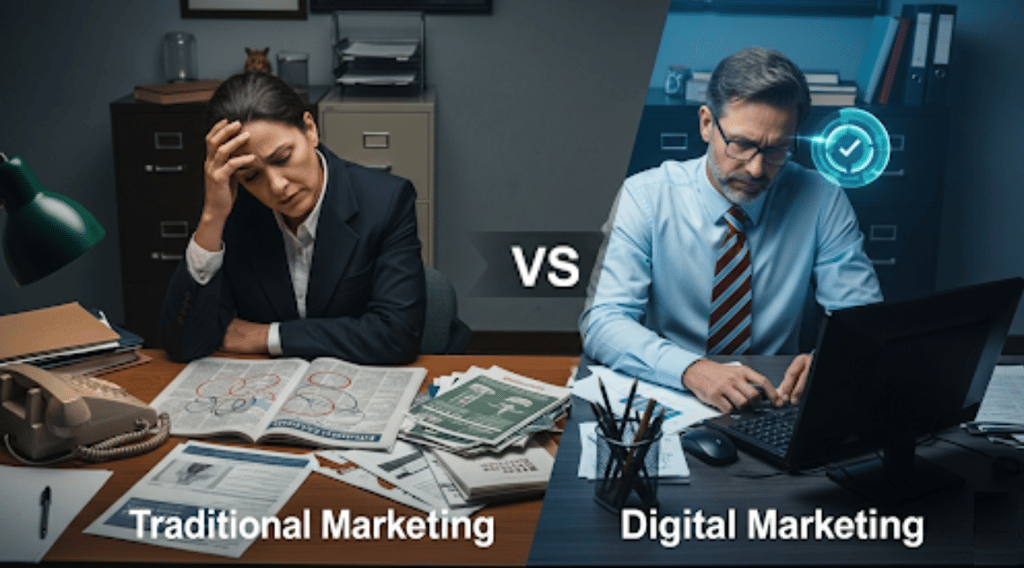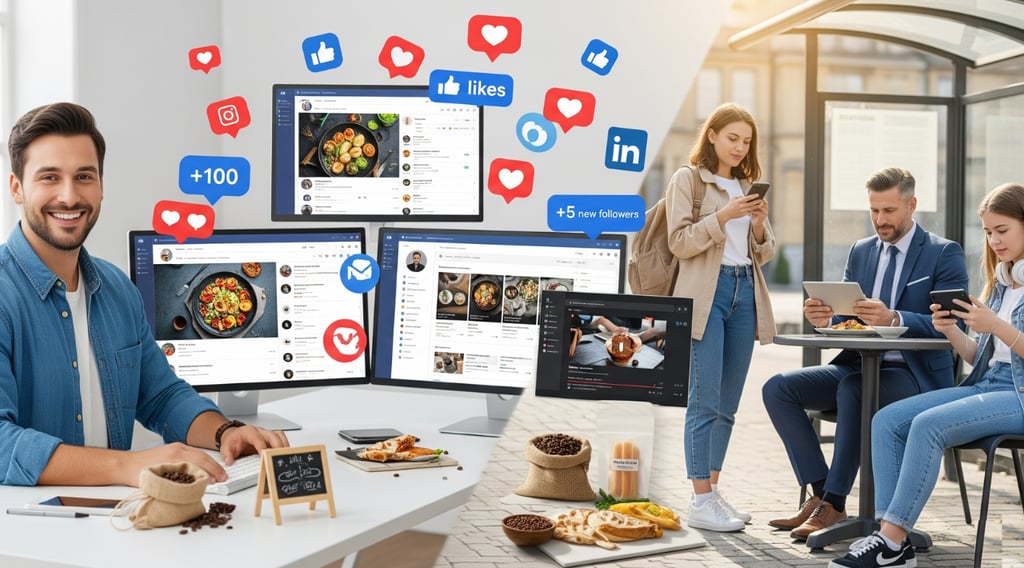Digital Marketing for Business: The Complete Guide to Growing Your Business Online in 2025
Discover essential digital marketing for business strategies that actually work. Learn SEO, social media, email marketing, and PPC tactics to grow your business online in 2025. Practical tips and tools included.
Eddy Enoma
8/18/202515 min read
Master proven digital marketing strategies that drive real results for your business in 2025
Your customers aren’t reading newspapers anymore. They’re scrolling Instagram at 2 AM, asking Google random questions, and making buying decisions based on TikTok videos.
If your business isn’t showing up in these digital spaces, you’re invisible to the people who matter most, your potential customers.
But here’s the reality: most business owners approach digital marketing like they’re throwing spaghetti at a wall, hoping something sticks.
Some try posting randomly on social media but get zero engagement. Others dump money into Google Ads without understanding why nobody’s clicking. Many jump between strategies every few weeks, never giving anything enough time to actually work.
The frustration is real. You want marketing that actually drives sales, not just vanity metrics. You need strategies that work for real businesses with real budgets, not just Silicon Valley startups with unlimited cash.
The best digital marketing approach handles your entire customer journey from the moment someone discovers your brand to when they become a loyal, repeat customer. In this guide, we’ll break down the essential digital marketing strategies that actually work in 2025, so you can choose the right ones for your specific business.
What Digital Marketing Really Means for Your Business
Digital marketing isn’t about being everywhere online; it’s about being where your customers are, when they’re ready to buy.
Think of it this way: traditional marketing is like shouting into a crowded room, hoping the right people hear you. Digital marketing is like having a conversation with someone who has already raised their hand and said, “I’m interested.”
The real power comes from meeting people at different stages of their buying journey. Someone searching “best coffee shops near me” is ready to buy right now. Someone reading “how to brew better coffee at home” might become a customer in a few months. Digital marketing lets you connect with both.
But here’s what most business guides won’t tell you: digital marketing isn’t just about technology and tactics. It’s about understanding human behavior in digital spaces. People browse differently online than they do in physical stores. They have shorter attention spans but access to unlimited information. They can compare prices instantly and read reviews from strangers they trust more than your sales copy.
This shift in behavior is exactly why traditional marketing approaches fall flat online. You can’t just take your newspaper ad and post it on Facebook. You can’t treat your email list like a direct mail campaign. Digital spaces require digital thinking.
Why Digital Marketing Isn’t Optional Anymore
Your Customers Have Already Gone Digital
Your competition figured this out years ago. While you’re debating whether digital marketing is worth it, they’re capturing customers who should be yours.
The numbers don’t lie: people spend over 7 hours a day looking at screens. They research products online before buying in-store. They trust online reviews more than personal recommendations.
Here’s a reality check: 97% of consumers search online for local businesses. 81% research a company online before making a purchase. 92% trust recommendations from people they don’t even know over branded content.
Your customers aren’t waiting for you to catch up. They’re making buying decisions right now based on what they find online. If your business isn’t part of that conversation, you’re not even being considered.
It Levels the Playing Field in Ways You Never Imagined
Remember when marketing was all about who had the biggest advertising budget? Those days are over.
A local bakery posting mouth-watering Instagram stories can get more engagement than a national restaurant chain with a million-dollar marketing budget. A solo consultant sharing valuable LinkedIn insights can attract bigger clients than established agencies. A small e-commerce store with great SEO can outrank major retailers.
Digital marketing rewards creativity, consistency, and customer focus over deep pockets. This is probably the first time in business history where small businesses have the same tools as Fortune 500 companies.
It’s Actually More Affordable Than Traditional Marketing
That newspaper ad that ran once and disappeared? It probably costs more than a Google Ads campaign that could run for months. Digital marketing lets you test small, measure everything, and scale what works.
You Get Real Data, Not Guesswork
Remember when marketing success was measured by “brand awareness” and other fluffy metrics? Digital marketing tells you exactly how many people saw your ad, clicked through to your website, and made a purchase. You can track every dollar you spend.
Small Businesses Can Compete With Big Corporations
A local bakery with great Instagram content can get more engagement than a massive chain restaurant. A freelance consultant with valuable LinkedIn posts can attract bigger clients than established agencies. Digital marketing is the ultimate equalizer.
The Digital Marketing Strategies That Actually Drive Results
Search Engine Optimization (SEO): Be There When They’re Looking
SEO is like being the answer to someone’s question before they finish asking it.
When someone types “best accounting software for small business” into Google, they’re not browsing; they’re hunting. They have a problem and they want it solved now. If your business shows up at the top of those results, you’re not interrupting their day; you’re saving it.
Here’s what actually moves the needle:
Creating content that answers real questions your customers are asking
Making sure your website loads fast (nobody waits around for slow sites)
Getting other reputable websites to link to your content
Optimizing for local searches if you have a physical location
Building topic authority by covering subjects thoroughly, not just creating random blog posts
The best part about SEO? Once you start ranking well, it’s like having a salesperson working 24/7, bringing in qualified leads while you sleep.
But here’s the reality most SEO guides skip: good SEO takes time. You’re not going to rank #1 for competitive keywords overnight. Google needs to trust your website, and trust is built over months, not days.
The businesses that succeed with SEO are the ones that play the long game. They consistently create valuable content, optimize their technical setup, and build relationships with other websites in their industry.
Tools like Surfer SEO can help you optimize content that actually ranks by analyzing what’s already working for your competitors. Instead of guessing what Google wants, you can see exactly what’s working in your industry.
Local SEO deserves special attention if you have a physical location or serve specific geographic areas. When someone searches “plumber near me” or “best pizza in Chicago,” Google is trying to connect them with nearby businesses. Optimizing your Google My Business profile, collecting local reviews, and creating location-specific content can help you dominate local search results.
Content Marketing: Stop Selling, Start Helping
Content marketing is the art of being so helpful that people actually want to hear from you.
Instead of constantly saying “buy our stuff,” you’re solving problems, answering questions, and proving your expertise. When someone finally needs what you sell, guess who they’ll think of first?
Content that actually works:
Blog posts that solve specific problems your customers face
Behind-the-scenes videos that show your process
Case studies that prove you can deliver results
Email newsletters that people actually look forward to reading
How-to guides that establish your expertise
Industry insights that position you as a thought leader
But here’s where most businesses go wrong: they create content for themselves, not their customers. They write about their company history instead of customer problems. They make videos about their awards instead of demonstrating value.
The best content marketing starts with understanding your customers’ journey. What questions do they ask before they’re ready to buy? What problems keep them up at night? What would make their job easier or their life better?
Tools like Jenni AI can help you research and outline comprehensive articles faster, ensuring you cover topics thoroughly rather than superficially. For optimizing that content for search engines, SEOWriting AI creates SEO-friendly content that actually ranks.
Video content deserves special mention because it’s become the preferred format for many audiences. But you don’t need Hollywood production values. Some of the most engaging business videos are simple screen recordings explaining how to solve common problems. Pictory makes it simple to turn your written content into engaging videos that actually get watched.
The compound effect of content marketing is where things get really interesting. Each piece of valuable content you create can work for years. Blog posts from 2020 are still driving traffic and generating leads in 2025. That’s the power of creating evergreen content that remains relevant over time.
Social Media Marketing: Meet People Where They Already Are
Social media isn’t about posting pretty pictures and hoping for likes. It’s about building relationships with people who could become customers.
Each platform serves a different purpose and attracts different audiences:
Instagram: Perfect for showing your products in action and building brand personality. Visual businesses like restaurants, fashion brands, and fitness coaches thrive here.
LinkedIn: Essential if you’re selling to other businesses or professionals. This is where B2B relationships are built and nurtured.
Facebook: Great for building communities and detailed targeting with ads. The audience skews older, making it perfect for many service-based businesses.
TikTok: Ideal for reaching younger audiences with creative, authentic content. Don’t dismiss it just because it seems “young”; the audience is aging up.
Twitter: Best for real-time customer service and industry conversations. It’s also excellent for thought leadership and news sharing.
The biggest social media mistake businesses make is trying to be everywhere at once. Each platform requires a different approach, different content formats, and different engagement strategies. It’s better to dominate one platform than to be mediocre on five.
Algorithm changes are a constant reality on social media. What worked last year might not work today. The platforms are constantly adjusting how they decide what content to show users. This is why organic reach feels harder than ever because it is.
The solution isn’t to chase every algorithm change. It’s to focus on creating genuinely engaging content that sparks conversations. When people comment, share, and engage with your posts, the algorithms take notice and show your content to more people.
Managing multiple platforms can feel overwhelming, but tools like Metricool let you schedule posts and track performance across all your accounts from one dashboard. You can see which posts perform best on each platform and adjust your strategy accordingly.
If you’re stuck on what to post, Predis AI can generate social media content that matches your brand voice and industry. It’s like having a creative team that never sleeps.
Social media advertising is where things get really interesting. Organic reach is limited, but paid social media advertising offers incredibly detailed targeting options. You can target people based on their interests, behaviors, demographics, and even their recent purchase history.
Email Marketing: Your Direct Line to Customers
Email marketing is like having a VIP list of people who actually want to hear from you.
These aren’t random strangers; they gave you their email address because they’re interested in what you offer. That makes them some of your most valuable prospects.
What actually gets results:
Welcome sequences that introduce new subscribers to your brand
Regular newsletters packed with useful information (not just sales pitches)
Automated emails for abandoned shopping carts
Personalized recommendations based on past purchases
Segmented campaigns based on customer behavior and preferences
The psychology of email marketing is fascinating. When someone gives you their email address, they’re making a small commitment to your brand. This psychological investment makes them more likely to pay attention to your messages and eventually make a purchase.
But here’s the catch: that trust can be broken instantly with irrelevant, overly promotional, or poorly timed emails. The businesses that excel at email marketing treat their subscribers’ inboxes with respect.
Email automation is where the real magic happens. You can set up sequences that nurture new subscribers, win back inactive customers, and turn one-time buyers into repeat customers, all without manual intervention.
Starting with email marketing doesn’t require a huge budget. EmailOctopus offers powerful features at affordable prices, perfect for businesses just getting started. As your list grows and your needs become more complex, GetResponse provides advanced automation and segmentation features.
For capturing email addresses in the first place, Magnetify makes it easy to create lead magnets that actually convert. Instead of generic “sign up for our newsletter” forms, you can offer valuable resources in exchange for email addresses.
Email deliverability is a technical aspect many businesses ignore until it’s too late. If your emails aren’t reaching inboxes, your entire email marketing strategy fails. This means following best practices like maintaining clean email lists, avoiding spam trigger words, and authenticating your sending domain.
Pay-Per-Click (PPC): Get Results Fast
PPC is instant gratification for marketers. Instead of waiting months for SEO to kick in, you can be showing up in search results within hours.
The key is understanding that PPC isn’t just about getting clicks, it’s about getting the right clicks from people ready to buy.
Types of PPC that actually work:
Google Search Ads for people actively looking for your products
Facebook Ads for reaching people based on interests and behaviors
YouTube Ads for demonstrating products visually
Retargeting ads for people who visited your website but didn’t buy
Shopping ads for e-commerce businesses show products directly in search results
The biggest PPC mistake most businesses make is treating it like a lottery. They throw money at ads, hope for the best, and wonder why they’re not profitable. Successful PPC requires strategy, testing, and constant optimization.
Keyword research is the foundation of successful search advertising. You need to understand not just what people search for, but what they mean when they search for it. Someone searching “cheap accounting software” has different intentions than someone searching “best accounting software for startups.”
Creating ads that actually convert is both an art and a science. AdCreative AI takes the guesswork out of ad design by generating high-converting creatives based on data from thousands of successful campaigns. Instead of relying on hunches about what might work, you can use data-driven designs.
Landing page optimization is where many PPC campaigns fail. You can have the perfect ad, but if it sends people to a confusing or irrelevant landing page, you’re wasting money. Your landing page should match your ad’s promise and make it easy for visitors to take the next step.
Budget management in PPC requires constant attention. It’s easy to burn through your monthly budget in a few days if you’re not monitoring performance. The key is starting with small budgets, testing what works, then scaling up successful campaigns while pausing underperforming ones.
Getting Started Without Losing Your Mind (Or Your Budget)
Start With Your Website Foundation
Your website is your digital headquarters. Everything else you do in digital marketing should drive people back to this home base.
Non-negotiables for your website:
Mobile-friendly design (most traffic comes from phones now)
Fast loading speeds (slow sites kill conversions)
Clear navigation that doesn’t confuse visitors
Obvious calls-to-action that tell people what to do next
Contact information that’s easy to find
If you’re starting fresh or need a complete overhaul, 10Web AI can build you a professional WordPress site using AI technology. For reliable hosting that won’t break the bank, Hostinger offers excellent performance (use referral code: OBO420 for extra savings).
Pick One Strategy and Master It
This is where most businesses mess up. They try to be everywhere at once and end up being nowhere effectively.
Instead, look at where your ideal customers spend their time and focus there first. B2B companies should probably start with LinkedIn and email marketing. Local businesses might focus on Google My Business and Facebook. E-commerce stores could prioritize Instagram and Google Ads.
Master one channel, then expand.
Set Up Proper Tracking From Day One
You can’t improve what you don’t measure. Set up Google Analytics on your website, connect your social media accounts to native analytics, and track which marketing efforts actually lead to sales.
This data will become your roadmap for making smart decisions about where to invest more time and money.
Advanced Strategies for Growing Businesses
Influencer Marketing: Borrow Trust and Credibility
Influencer marketing works because it leverages something you can’t buy: trust. When an influencer recommends your product to their audience, they’re lending you their credibility.
But the days of paying celebrities millions for a single post are mostly over. Micro-influencers (1,000–100,000 followers) often deliver better results than mega-influencers because their audiences are more engaged and trusting.
What works in influencer marketing:
Partnering with influencers whose audiences match your target market
Focusing on long-term relationships rather than one-off posts
Giving influencers creative freedom to present your product authentically
Tracking actual sales, not just likes and comments
Marketing Automation: Work Smarter, Not Harder
Marketing automation is like hiring a tireless employee who works 24/7, never takes sick days, and never forgets to follow up with leads.
Automation opportunities most businesses miss:
Welcome sequences for new email subscribers
Follow-up sequences for abandoned shopping carts
Re-engagement campaigns for inactive customers
Lead scoring and nurturing based on behavior
Social media post scheduling and response management
The goal isn’t to remove the human element from your marketing; it’s to free up your time for the high-value activities that require human creativity and judgment.
Conversion Rate Optimization: Get More from Existing Traffic
Getting more website traffic is expensive. Converting more of your existing traffic into customers is much more cost-effective.
High-impact areas for conversion optimization:
Simplifying your checkout process
Improving your website’s loading speed
Adding customer testimonials and social proof
Clarifying your value proposition
Making your contact information easy to find
Small changes can have big impacts. Something as simple as changing your button color or headline can increase conversions by 20% or more.
Digital marketing involves juggling a lot of moving parts. The right tools can automate the repetitive stuff so you can focus on strategy and creativity.
Essential tools for different needs:
SEO and Content Creation:
Surfer SEO for optimizing content that actually ranks
Rytr for generating marketing copy quickly
Video Marketing:
InVideo for creating professional marketing videos
HeyGen for AI-powered video creation
Vidau AI for automated video marketing campaigns
Organization and Productivity:
Taskade AI for keeping marketing projects organized
Reclaim AI for time management and scheduling
Design and Visuals:
Canva for quick, professional-looking graphics
Remember: you don’t need every tool that exists. Start with the basics and add more as your needs grow.
Mistakes That Kill Digital Marketing Results
Treating Social Media Like a Billboard
Social media is called “social” for a reason. People don’t want to be sold to constantly; they want to engage, learn, and be entertained.
Follow the 80/20 rule: 80% valuable, helpful content, 20% promotional content. Build relationships first, and sales will follow.
The authenticity trap: Many businesses think “authentic” means unprofessional. That’s not true. You can be authentic while still maintaining quality standards. Authenticity means being genuine about your values and honest about your capabilities.
Ignoring Mobile Users
Over 60% of internet traffic comes from mobile devices. If your website, emails, or ads don’t work well on phones, you’re essentially telling most of your potential customers to go elsewhere.
Mobile optimization goes beyond responsive design. It includes fast loading times, easy navigation with thumbs, readable text without zooming, and forms that don’t make people want to throw their phone across the room.
Expecting Overnight Success
Digital marketing is like going to the gym. You won’t see results after one workout, but stick with it consistently, and the results compound over time.
Most successful digital marketing campaigns take 3–6 months to really hit their stride. The businesses that succeed are the ones that commit to the long game while making smart adjustments along the way.
Not Testing Anything
What works for one business might flop for another. The only way to know what works for your specific audience is to test different approaches and measure the results.
A/B testing should be built into everything you do. Test email subject lines, ad headlines, social media post formats, website layouts, and call-to-action buttons. Small improvements across multiple areas compound into significant results.
Focusing on Vanity Metrics Instead of Business Results
Lots of likes and followers might feel good, but they don’t pay the bills. Many businesses get addicted to vanity metrics because they provide instant gratification, but they can be misleading.
A business with 1,000 engaged email subscribers who regularly buy products is more valuable than a business with 100,000 social media followers who never purchase anything.
Measuring What Actually Matters
Focus on Revenue, Not Vanity Metrics
Lots of likes and followers might feel good, but they don’t pay the bills. Focus on metrics that directly impact your bottom line:
Website traffic from your target audience (not just any traffic)
Email subscribers (people who are interested enough to give you their contact info)
Conversion rates (how many visitors actually become customers)
Customer lifetime value (how much money each customer is worth over time)
Return on ad spend (how much revenue you generate for every dollar spent)
Use the Right Tools to Track Performance
Free Options:
Google Analytics for website performance
Google Search Console for SEO insights
Native analytics on each social media platform
Paid Options (Worth the Investment):
Email marketing platform analytics
Social media management tools with advanced reporting
Customer relationship management (CRM) systems
The Future is Bright (And Full of Opportunities)
Digital marketing is evolving faster than ever. AI is making content creation easier, voice search is changing how people find information, and new platforms are constantly emerging.
But here’s what won’t change: the fundamental need to provide value to your customers and meet them where they are.
The businesses that succeed in digital marketing aren’t necessarily the ones with the biggest budgets or the latest technology. They’re the ones that consistently show up, provide value, and adapt to their customers’ changing needs.
Your Next Steps
Digital marketing doesn’t have to be overwhelming. Start with these three steps:
Audit your current digital presence: Google your business name and see what comes up. Check your website on a mobile device. Look at your social media profiles from a customer’s perspective.
Choose one primary strategy: Based on where your customers spend time, pick one digital marketing channel to focus on for the next 90 days.
Set up basic tracking: Install Google Analytics, set up conversion tracking, and establish a baseline for measuring improvement.
The digital world is full of opportunities for businesses that are willing to meet their customers where they already are. Your competitors are probably already there. The question is: when will you join them?
Ready to stop guessing and start growing? Pick one strategy from this guide, commit to it for 90 days, and prepare to be surprised by what’s possible when you finally meet your customers in the digital spaces they actually use.
Now, let’s get you set up for success. Explore our full collection of hand-picked tools and resources to help streamline your digital marketing efforts. Find them all on our Resources Page.
Ready for more?
For weekly insights, exclusive tips, and the latest digital marketing trends delivered straight to your inbox, subscribe to our newsletter using the form below.
Subscribe for Exclusive Tips & Updates. Enter Your Email Below!



Get the latest strategies on content creation, freelancing, and affiliate marketing, plus passive income straight to your inbox!
🔒 We respect your privacy. Your email is safe with us. Unsubscribe anytime.
Address
Sporerweg 16
94234 Viechtach, Germany
Contacts Us
(049) 170 499 6273
Subscribe to our newsletter
© 2026 Onlinebizoffers. All rights reserved.








